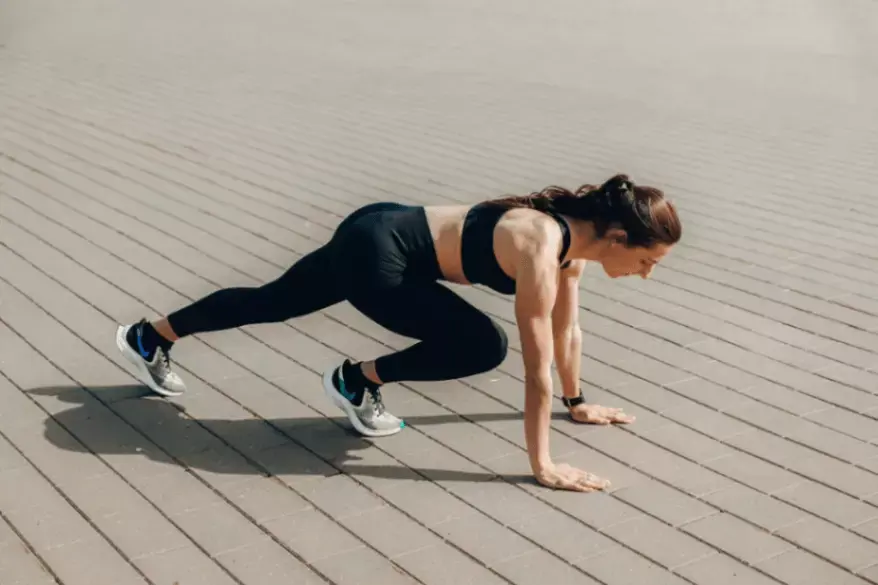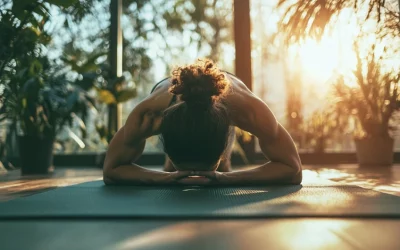Picture this: You crushed your workout yesterday, feeling unstoppable—until today. Your muscles are so sore that even walking feels like a challenge, forcing you to skip today’s session. The culprit? Skipping a proper warm-up. Warming up isn’t just a box to check; it’s the key to unlocking better performance, faster recovery, and injury prevention.
In 2025, fitness is smarter than ever, and static stretching alone just won’t cut it. Dynamic stretching, the go-to method for athletes and fitness enthusiasts, is all about movement—engaging your muscles through controlled, active motions that prepare your body for the challenges ahead. It’s fast, effective, and proven to enhance your workout results.
In this guide, we’ll explore targeted dynamic stretching routines designed to get your body primed for action, boost flexibility, and prevent injury. Plus, we’ll show you how to perform each movement correctly to maximize your gains and keep you moving strong.
Get ready to level up your warm-up game—because the best workouts start before you even break a sweat.
Why Is a Pre-Workout Warm-Up Routine Important?
Warming up before a workout is important for preparing your body to handle the physical demands of exercise.
One of the key benefits of warming up is reducing injury risk. By moving your muscles and joints through a controlled range of motion, you help them get ready for the more intense activity to come. This preparation makes your muscles more elastic and your joints more mobile, which reduces the likelihood of strains, sprains, or other injuries during your workout.
A good warm-up boosts blood flow, delivering oxygen and nutrients to your muscles to enhance efficiency during your workout. This leads to improved muscle activation, better endurance, and overall enhanced performance.
Warming up your muscles makes them more flexible, allowing for a greater range of motion. This increased flexibility can help you move more freely and effectively during your exercises, allowing for smoother, more controlled movements.
 Full Body Dynamic Stretching Routine
Full Body Dynamic Stretching Routine
1. Arm Swings
Arm swings help improve mobility, loosen up the shoulder joints, and engage surrounding muscles.
To begin, start with forward and backward arm swings. Stand tall with your feet shoulder-width apart, keeping your arms relaxed at your sides. Swing both arms forward in a controlled, circular motion, then reverse the direction to bring them backward. This movement helps loosen up your shoulder joints and gradually increases your range of motion.
Next, incorporate cross-body arm swings to further target the upper body. While maintaining the same stance, extend your arms out to your sides. Swing one arm across your chest while the opposite arm moves outward, alternating back and forth. This variation actively engages your chest and upper back muscles, improving flexibility across the upper body.
2. Torso Twists
Torso twists can help to warm up the muscles around your abdomen, lower back, and obliques, which prepares your body for many activities with movements that involve twisting or turning.
To perform standing torso twists, stand with your feet shoulder-width apart. Keep your knees slightly bent and your arms raised in front of you, parallel to the ground. Slowly rotate your torso to one side, keeping your hips facing forward. Then, rotate in the opposite direction. This fluid, controlled motion helps increase the range of movement in your spine and core without straining them.
For those who find standing positions uncomfortable or want a more controlled motion, seated torso twists are a good alternative. Sit on a chair or the floor with your feet flat and knees bent. Place your hands on your thighs or behind your head, and rotate your torso to each side, keeping your spine straight.
3. Leg Swings
Leg swings are an effective way to prepare your lower body for a workout by increasing hip mobility and activating key muscle groups. Incorporating them into your warm-up routine helps loosen up your hips and get the blood flowing to your legs.
To start, use forward leg swings. Stand next to a wall or something stable for balance. Swing one leg forward in a controlled motion until you feel a stretch in your hamstrings, then swing it back. This movement helps loosen the hips and activate the hamstrings.
Next, perform side leg swings. Stand with both hands on a wall for support, and swing your leg from side to side. This exercise improves lateral hip mobility and strengthens the hip abductors, which are important for stability and balance during exercises like squats or lateral movements.
Lastly, add in backward leg swings. Stand tall and swing one leg backward in a smooth motion. This activates your glutes and prepares both your lower back and hamstrings for more intense movements, such as running or lifting.
4. High Knees
High knees are a staple in any dynamic warm-up routine as they help increase your heart rate and prepare the lower body for more intense movements.
Start by standing tall with your feet hip-width apart, then drive one knee upward towards hip level while simultaneously lifting the opposite arm. Your goal is to quickly alternate legs, bringing each knee up as high as possible while maintaining an upright posture. Make sure that your core stays engaged to support proper alignment and prevent leaning backward or forward.
This movement isn’t just about raising your knees. High knees are a full-body exercise that activates the quads, hamstrings, and glutes. The fast pace of the exercise also raises your heart rate, making it an excellent way to get your cardiovascular system ready for a workout.
For more variety, you can incorporate an arm drive where you focus on pumping your arms as you lift your knees which helps to mobilize your upper body further. Another variation is to add a skip into the movement, which introduces a more dynamic element and challenges your coordination.
5. Walking Lunges with Torso Rotation
Walking lunges with torso rotation are a valuable exercise for your dynamic warm-up routine, helping to engage multiple muscle groups while improving flexibility and balance.
At first, step forward with one leg and lower your body into a lunge position. Keep your front knee directly above your ankle and your back knee bent toward the ground, making sure that both knees form roughly 90-degree angles. As you move into the lunge, maintain a strong, upright posture.
Once you’re in the lunge, add a torso rotation. Rotate your upper body toward the side of your front leg, activating your core muscles as you twist. This rotation helps improve your rotational flexibility, which is important for sports and activities involving movement in different directions.
As you alternate legs and repeat the movement, focus on keeping your core engaged and your movements controlled. Maintaining balance helps to avoid straining your muscles or losing form. This exercise not only stretches your lower body muscles but also activates your core.
6. Inchworms
Inchworms are a dynamic stretch that targets multiple key muscle groups. To perform an inchworm, stand tall with your feet hip-width apart, then bend forward at the hips, keeping your legs as straight as possible, and reach down to touch the ground with your hands. From there, walk your hands forward until your body forms a straight line in a plank position. Hold briefly, then walk your feet towards your hands, returning to the starting position.
This movement actively mobilizes your core, hamstrings, and shoulders, making it an efficient full-body warm-up. The core is activated as you stabilize yourself during the plank, while your hamstrings stretch and lengthen as you bend at the hips. Your shoulders and arms also get involved as you support your body weight when walking your hands forward.
For a more challenging variation, you can add a push-up once you reach the plank position. This increases activation in your chest and triceps, adding a strength-building element to the stretch.
7. Butt Kicks
Butt kicks are a valuable exercise routine for activating the hamstrings, the muscles at the back of your thighs, as repeatedly contracting and relaxing these muscles prepares them for more intense movements during your workout. Butt kicks also elevate your heart rate, contributing to increased cardiovascular readiness.
To perform butt kicks correctly, start by lifting your heels toward your glutes in a repetitive, rhythmic motion. Alternating legs quickly, you aim to get your heels as close to your glutes as possible. Your arms can move naturally at your sides or in a running motion, which helps maintain balance and rhythm.
For beginners or those easing into physical activity, a walking variation of butt kicks can be performed. Instead of running in place, you walk forward while bringing your heels up toward your glutes. This version allows for a more gradual warm-up, gently increasing heart rate and muscle activation.
8. Hip Circles
Hip circles are effective in improving hip mobility and flexibility. To start, stand with your feet shoulder-width apart and place your hands on your hips for balance. Begin by rotating your hips in a slow, controlled circular motion, as if drawing large circles with your pelvis. Complete several circles in one direction, then alternate to the opposite direction.
For balanced hip mobility, remember to rotate clockwise for a set number of repetitions and switch to counterclockwise rotations to make sure that you achieve even flexibility. These movements help loosen up the hips and increase your range of motion in exercises like squats, lunges, or any activity requiring lower-body strength and stability.
9. Dynamic Side Lunges
Dynamic side lunges can help to prepare your lower body for movement in multiple directions. Standing with your feet hip-width apart, step one foot out to the side while keeping the other leg stationary. As you step, lower your hips and bend the knee of the stepping leg, moving into a deep lunge position. Your stationary leg should remain straight. Once you’ve reached the lowest point of the lunge, push off the bent leg and return to the starting position. Repeat on the other side.
These lunges are particularly valuable for strengthening your glutes, quads, and hamstrings, which are key muscles for lower body stability and power. They also improve your lateral movement, which is important for sports and activities that require side-to-side agility, like tennis or basketball. Keep your chest upright throughout the movement, and make sure that the knee of your stepping leg stays aligned with your foot. This helps prevent unnecessary strain on your joints while maximizing the benefits of the exercise.
Key Points for a Successful Dynamic Stretching Routine
When performing a dynamic stretching routine, there are several key points to keep in mind to make sure that you get the most out of each movement while reducing the risk of injury.
An important element is maintaining proper form throughout your stretches. Correct technique makes sure that you’re targeting the right muscles and joints, which improves the overall effectiveness of the routine. Poor form can lead to unnecessary strain, so always focus on doing the exercises correctly. You can use stretching apps featuring virtual guidance, such as WeStretch, to help you with this.
Controlled, fluid movements are another essential factor. Dynamic stretching is meant to gradually increase your range of motion, so avoid jerky or rushed motions. Moving too quickly can cause muscle strain, while smooth, steady motions allow your body to warm up safely and effectively.
Finally, listen to your body. If something feels off or you experience discomfort, it’s important to adjust your movements or stop altogether. Stretching shouldn’t be painful. The goal is to prepare your muscles for activity, not push them to their limits.
Exercise Smarter with WeStretch: Your All-in-One Stretching Assistant
A consistent full-body stretching routine is essential for improving flexibility, supporting injury prevention, and enhancing overall well-being. Carefully following simple yet effective stretches targeting the hamstrings, hip flexors, back, quads, chest, and shoulders, individuals of any fitness level can reap the benefits.
Regular stretching, with attention to proper form and consistency, can help you move more freely, recover faster, and feel better in everyday activities.
Looking for a way to add some fun to your stretching routine? Check out WeStretch—an app that’s like your own personal stretch coach! With tailored plans, easy-to-follow demos, and progress tracking, it’s got everything you need to keep you limber and on point. Ready to get flexible? Sign up today and let’s get stretching!
FAQ
What is a full-body dynamic stretch?
A full-body dynamic stretch is an active stretching routine that targets major muscle groups through controlled, continuous movements. It improves flexibility, increases blood flow, and prepares the body for physical activity. Unlike static stretching, dynamic stretching involves motion, such as leg swings, arm circles, and lunges, helping to improve the range of motion and reduce the risk of injury. These exercises are ideal for warming up before a workout.
What is the best full-body stretch?
The best full-body stretch involves dynamic movements that activate multiple muscle groups. Examples include leg swings, arm circles, walking lunges, and torso twists. These stretches help improve flexibility, increase blood flow, and prepare your body for physical activity. Perform each movement slowly and with control, gradually increasing intensity. Aim for 5-10 minutes of dynamic stretching before your workout for optimal results.
What happens when you do a full-body stretch?
A full-body stretch activates multiple muscle groups, increases blood flow, and improves flexibility. It helps prepare your body for physical activity by improving joint mobility and reducing stiffness. Dynamic stretches, in particular, mimic movements in your workout, promoting better performance and reducing the risk of injury.
How many times a week should you do dynamic stretching?
For optimal results, dynamic stretching should be performed 3-5 times a week. Incorporating it into your warm-up routine before each workout helps improve flexibility, increase blood flow, and reduce the risk of injury. Focus on full-body routines that target major muscle groups relevant to your activity.
How long should a full-body dynamic warm-up be?
A full-body dynamic warm-up should typically last 5 to 10 minutes. This duration is enough to increase blood flow, elevate your heart rate, and prepare your muscles for more intense activity. Focus on exercises that target major muscle groups and mimic the movements of your upcoming workout. Adjust the length based on your fitness level and exercise intensity.






